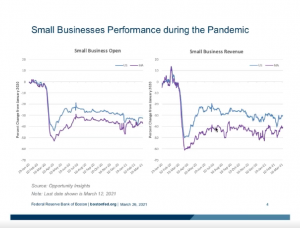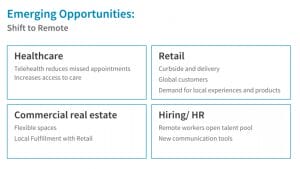State House News Service Weekly Roundup: One Step Forward, Two Steps …
Article Source: State House News Service
Author: Matt Murphy
If Massachusetts used to run on Dunkin’, it now runs on Pfizer, and Moderna, and Johnson & Johnson.
The state’s long-term prognosis remains inextricably wrapped up in the ability of state and federal government, pharmacies and health care providers to administer as many shots as possible as fast as possible.
But even as vaccine supply grows and the number of Massachusetts residents fully vaccinated eclipsed 1.37 million this week, the coronavirus appears to be catching up in the arms race against the vaccine and a lot is riding on who wins out.
“Right now I’m scared,” said Centers for Disease Control and Prevention Director Rochelle Walensky, describing her sense of “impending doom” about the rise in cases in states like Michigan and New York and, yes, Massachusetts.
Walensky’s emotional plea for vigilance came the day before she came back to Massachusetts, where she lived and worked before joining the Biden administration, to tour the new FEMA-supported mass vaccination site at the Hynes Convention Center. The Hynes site replaced Fenway Park, where baseball returned on Friday, and FEMA’s involvement means there will be enough vaccine to administer 7,000 doses a day at the Back Bay center, up from the 1,000 shots a day the state was doing alone.
The state next week will use some of the additional FEMA supply to deploy mobile vaccination units in Chelsea, Revere, Boston, New Bedford and Fall River.
But even Baker acknowledged this week that the positive trends that led him to open up venues like Fenway for limited spectators were going in the wrong direction.
The seven-day average of new COVID-19 cases detected daily was up 29 percent on March 30 from March 8 to 1,888, schools reported their highest ever weekly caseload of 1,045, and the number of communities in the high risk category increased for the third straight week to 55. Almost half of the new cases were recorded in residents under 30, many of whom have to wait a few more weeks to become vaccine eligible.
“I think it’s fair to say that no one can let their guard down with respect to this virus,” Baker said.
The good news is that the administration is expecting a major influx of Johnson & Johnson vaccine next week – more than 100,000 doses – and does not believe the mixup at the Baltimore manufacturing facility that spoiled 15 million doses will impact that delivery.
Baker has gotten beaten up by legislative Democrats in recent weeks for his handling of the pandemic, and in particular the vaccine rollout, but Walensky was unwilling to second guess the Republican, at least to his face, and most Massachusetts residents, according to a new poll, are willing to cut him some slack.
The newest Boston Globe/Suffolk poll found that 71 percent of residents approved of the governor’s handling of the pandemic. He got lower numbers for his vaccine effort – 58 percent approved – but 67 percent said they support the job Baker is doing overall.
So as the first fundraising quarter came to a close this week, Baker, the polling suggests, remains in the catbird seat should he choose to seek a third term.
Ben Downing, so far the most prominent Democrat in the 2022 race for governor, reported raising $227,712 in the eight weeks since he entered the race on Feb. 8. This week he picked the issue of colleges withholding transcripts from students for unpaid bills to go after Baker for underfunding higher education.
Another potential gubernatorial contender in 2022 also had college students on her mind this week. Attorney General Maura Healey hosted U.S. Sen. Elizabeth Warren and U.S. Rep. Ayanna Pressley to help call on President Joe Biden to use his executive authority to forgive up to $50,000 in student loan debt for federal student borrowers.
Biden’s chief of staff told POLITICO the president was undecided on what to do with respect to student debt, despite Biden previously saying he thought Congress, not the White House, should act. “Well that’s great,” Pressley said in response.
The next generation of student borrowers also found out this week that they won’t have to pass the MCAS exam in order to graduate in 2022 under a plan put forward by Education Commissioner Jeff Riley that would scale back the state’s standardized testing program during the pandemic. It didn’t go far enough for the Massachusetts Teachers Association and other critics who would like to see MCAS postponed completely this spring until next year.
While Biden waits for more legal guidance on his authority to address student debt, his administration – including Labor Secretary Marty Walsh – was busy rolling out and beginning to sell a more than $2 trillion infrastructure package.
U.S. Rep. Stephen Lynch said that given the clout of the Massachusetts delegation and the seats it holds on the Transportation Committee, a package that large could be a feeding frenzy for Massachusetts road, bridge and rail projects.
Any infrastructure funding would come in addition to billions of dollars on its way from the “American Rescue Plan,” which lawmakers began to pick apart this week. The House Committee on Federal Stimulus and Census Oversight held its first oversight hearing this week where Bharat Ramamurti, deputy director of the National Economic Council, said details about how state and local governments can spend the money will come by early May.
That committee will be back at it next week with Administration and Finance Secretary Michael Heffernan expected to testify.
But with the exeception of hearings like this, the process of committees reviewing the thousands of bills filed by lawmakers on Beacon Hill this year has been slow to start, with most pieces of legislation still waiting to be assigned.
In contrast, the Legislature has picked up its oversight game.
There have been stimulus oversight hearings and two explorations of the COVID-19 vaccine rollout. The special oversight committee probing the early pandemic outbreak of COVID-19 at the Holyoke Soldiers’ Home is seeking to extend its investigation and has invited former Veterans’ Services Secretary Francisco Urena to testify next week.
And now the Committee on Children, Families and Persons with Disabilities says it will hold an oversight hearing into a troubling report from Child Advocate Maria Mossaides that found the Department of Children and Families missed the signs of abuse and neglect that led to the Oct. death of 14-year-old David Almond in Fall River.
That’s not to say the Legislature has been completely dormant, and House and Senate leaders may want to act quickly on Baker’s proposed amendments to a COVID-19 sick leave program that the governor returned at the same time he signed a tax relief bill for businesses and those who were unemployed over the past year. The new law offers tax breaks on unemployment benefits and limits rate increases on employers for unemployment insurance, but Baker recommended a few modifications to the sick leave program before he’s ready to sign off on that too.
“Providing paid sick leave is crucial to protecting our workforce and preventing the further spread of COVID-19. The House and the Senate will continue to prioritize this issue and will work together to review the amendments and return the bill back to the Governor’s desk,” two spokespeople for Speaker Ron Mariano and Senate President Karen Spilka said in a statement.
While it’s not a legislative oversight committee, the new Peace Officer Standards and Training (POST) Commission will have oversight of police officers around the state, and the law enforcement community learned this week who will sit in those nine seats.
Former Massachusetts Superior Court Judge Margaret Hinkle was tapped by Baker to chair the commission, and Baker and Healey filled in the remaining seats in accordance with the landmark reform law passed in the aftermath of the killing of George Floyd.
Incidentally, the commission took shape the same week that former Minneapolis police officer Derek Chauvin went on trial for Floyd’s murder.








